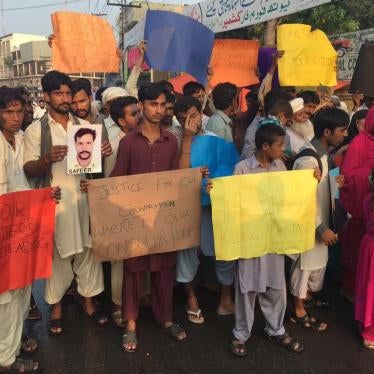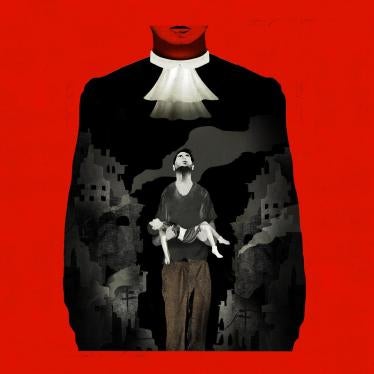1. What was the Anfal?
The Anfal (meaning the “the Spoils” in Arabic) was an eight-stage military campaign that resulted in the deliberate murder of at least 50,000 and possibly 100,000 Kurds. During the Anfal, Iraqi forces used chemical weapons on numerous occasions against the Kurds. The Anfal lasted from late February to early September 1988. The victims, including women, children and the elderly, were selected because they were Kurds who remained on their traditional lands in zones outside of areas controlled by Baghdad. Following its investigations in 1992-1993, Human Rights Watch categorized the Anfal as a genocide against part of the Iraqi Kurdish population in the north.
2. Who are the defendants at trial?
The Iraqi High Tribunal is trying six defendants who held key positions during the Anfal campaign. They are (listed by their positions at the time):
Ali Hassan al-Majid, secretary-general of the Northern Bureau of Iraq's Ba'ath Arab Socialist Party who was granted special powers over Northern Iraq equivalent to that of the president;
Sultan Hashem Ahmed, military commander of the campaign;
Sabir Abdul-Aziz al-Duri, director of military intelligence;
Hussein Rashid al-Tikriti, deputy of operations for the Iraqi forces;
Tahir Tawfiq al-Ani, governor of Mosul
Farhan Mutlak al-Jubouri, head of military intelligence in Northern Iraq.
Charges against Saddam Hussein were dropped after his execution on December 30, 2006.
All six defendants are charged with genocide, war crimes and crimes against humanity. Charges include willful killing, enslavement, and imprisonment or other severe deprivation of physical liberty as crimes against humanity. War crimes charges include intentionally directing attacks against the civilian population; intentionally directing attacks against cultural, religious, medical, educational, or other buildings not used for military purposes; and the destruction or seizure of property not imperatively demanded by the necessities of the conflict.
3. What is the significance of the Anfal trial?
Unlike the recently-concluded Dujail trial, which concerned horrific killings in one village, the crimes of the Anfal were massive in scale. Although nominally a conflict with Kurdish militia, known as pershmerga, the Anfal involved mass executions and disappearances of tens of thousands of ordinary Kurdish citizens - men, women and children. Government forces used chemical weapons and destroyed some 2,000 villages. Hundreds of thousands of villagers were forcibly displaced.
4. What acts constitute the crime of genocide?
The widespread commission of the following acts, together with a specific intent to eliminate the Kurds, in whole or in part, based on their ethnicity, would constitute genocide: killing, causing serious bodily or mental harm, deliberately inflicting conditions of life calculated to bring about their physical destruction, imposing measures intended to prevent births, or forcibly transferring children from their community.
To prove genocide took place the IHT prosecutor has to show that some or all of the above acts were committed and that they were done with the specific intent and purpose of destroying a part of the Iraqi Kurdish population.
5. How many people need to be eliminated for killings to be considered a genocide?
In previous genocides (e.g. the Holocaust, the Armenian and Rwandan genocides) the number of murders was vast. This scale by itself helped to demonstrate that the killing was carried out on the basis of the victims’ religious belief or ethnicity. There is, however, no specific quantitative threshold that must be crossed in order for widespread killings to be considered a genocide. Genocide involves the destruction of either the “whole” or a “part” of the targeted group.
The targets of the Anfal were the Iraqi Kurds living in northern rural areas designated as “prohibited zones” by the government. With the Anfal, evidence other than sheer numbers can show that the Kurds were targeted because of their ethnicity.
6. How do we know the killings were carried out against the rural Kurds because they were Kurds? Wasn’t the Anfal a counter-insurgency operation?
Iraqi Kurds had been under assault by the Iraqi government since the 1970s. The Anfal was the culmination of that assault. Baghdad had frequently referred to the Kurds as a threat to the nation. The government tried to "Arabize" Kurdish-populated areas by encouraging Arab migrant farmers to move there. It wanted to do this because the region is strategically located close to the Iranian border.
After 1980, and the beginning of the eight-year Iran-Iraq war, Kurds in the north gained more control over the region and developed closer ties to Iran. By 1986 the Kurds had established a formal political and military agreement with Tehran. The Iraqi government, feeling that the region was not secure, began the Anfal campaign, and the ensuing repression targeted all Kurds living in the “prohibited zones.”
7. What evidence is there that crimes committed against the Kurds were intended to destroy them as a group?
The Iraqi government created so-called “prohibited zones” in Iraq with the order to execute anyone found living in those zones. The boundaries of those zones corresponded to the areas of Northern Iraq populated almost exclusively by rural Kurds.
The claim that those killed or removed from the “prohibited zones” were insurgents, or insurgent sympathizers, is not credible because young children were among the tens of thousands of Anfal victims. In addition, the Iraqi government did not make exceptions on the basis of political loyalties; chemical weapons were threatened against Kurds who were loyal to the government as well.
The government claimed that the Kurds supported Iran in the Iran-Iraq war. However, even if this were true, it could not justify the extent of the killing in the prohibited zones, in particular the killing of women, children and men who did not take part in hostilities. They were killed because they were Kurds.
8. What does Human Rights Watch see as the main obstacles to a fair trial?
Human Rights Watch's observed the Dujail trial and saw a number of serious shortcomings in how the Iraqi High Tribunal functioned.
These include: 1) An almost complete lack of familiarity with international criminal law on the part of all Iraqi lawyers and judges involved in the trial; 2) Chaotic and inadequate administration which has given rise to major problems in performing basic administrative tasks necessary for a trial of this magnitude to run fairly; and 3) Such extensive use of anonymous witnesses that the defendants were deprived the right to contest the evidence against them.
These shortcomings have been compounded by the sharp deterioration of the security environment in Iraq which has resulted in the murder of three defense lawyers, the reluctance of numerous witnesses to come forward, and serious limitations on the defense's capacity to investigate and contest evidence gathered by the prosecution.
Human Rights Watch has other concerns about the defendants’ rights to a fair trial specifically related to the Anfal proceedings, including political interference. The the Iraqi Prime Minister and Cabinet removed the presiding judge on September 19, 2006 after he made remarks perceived as favorable to the defense. Human Rights Watch has also raised concerns about vague charges which made it difficult for the accused to prepare their defense. In addition, the court refused defense requests to accommodate witnesses through videolink testimony from embassies abroad or through grants of immunity for purposes of providing testimony. As a result, only a handful defense witnesses were presented, almost all of whom were character witnesses who did not testify to the substance of the evidence presented.
For justice to be done, this important trial must be conducted fairly. Based on extensive observation of the IHT's conduct of its first trial, Human Rights Watch believes that it is presently incapable of fairly and effectively trying genocide in accordance with international standards and current international criminal law.
9. What is Human Rights Watch’s view of the death penalty for those who are found guilty?
Human Rights Watch opposes the death penalty. From a human rights perspective, the death penalty constitutes a cruel and inhuman punishment. The trend in international law is towards abolition of the death penalty. However horrific the alleged crimes, the death penalty is unwarranted.
10. What was Human Rights Watch’s role in documenting the Anfal?
In 1992, after the Gulf War, Human Rights Watch sent a team of researchers to northern Iraq. For several months the team conducted extensive investigations. Its members interviewed some 350 Anfal survivors and witnesses and conducted soil analysis in areas where chemical weapons had been used. For purposes of safe keeping and analysis, Human Rights Watch was given 18 metric tons of Iraqi security documents that had been seized by Kurdish militias when government security forces abandoned the region. On the basis of the field research and analysis of documents, Human Rights Watch concluded that the Anfal constituted genocide. In 1994-95, Human Rights Watch attempted to persuade several human rights-minded governments to bring a case against the government of Iraq under the provisions of the Genocide Convention at the International Court of Justice. Unfortunately, nothing came of this initiative.






